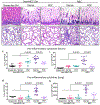The administration of a pre-digested fat-enriched formula prevents necrotising enterocolitis-induced lung injury in mice
- PMID: 34632971
- PMCID: PMC8995403
- DOI: 10.1017/S0007114521004104
The administration of a pre-digested fat-enriched formula prevents necrotising enterocolitis-induced lung injury in mice
Abstract
Necrotising enterocolitis (NEC) is a devastating gastrointestinal disease of prematurity that typically develops after the administration of infant formula, suggesting a link between nutritional components and disease development. One of the most significant complications that develops in patients with NEC is severe lung injury. We have previously shown that the administration of a nutritional formula that is enriched in pre-digested Triacylglyceride that do not require lipase action can significantly reduce the severity of NEC in a mouse model. We now hypothesise that this 'pre-digested fat (PDF) system' may reduce NEC-associated lung injury. In support of this hypothesis, we now show that rearing newborn mice on a nutritional formula based on the 'PDF system' promotes lung development, as evidenced by increased tight junctions and surfactant protein expression. Mice that were administered this 'PDF system' were significantly less vulnerable to the development of NEC-induced lung inflammation, and the administration of the 'PDF system' conferred lung protection. In seeking to define the mechanisms involved, the administration of the 'PDF system' significantly enhanced lung maturation and reduced the production of reactive oxygen species (ROS). These findings suggest that the PDF system protects the development of NEC-induced lung injury through effects on lung maturation and reduced ROS in the lung and also increases lung maturation in non-NEC mice.
Keywords: Infant nutrition; Lung injury; Necrotising enterocolitis; Reactive oxygen species.
Conflict of interest statement
Figures









References
-
- Seeman SM, Mehal JM, Haberling DL et al. (2016) Infant and maternal risk factors related to necrotising enterocolitis-associated infant death in the United States. Acta Paediatrica, International Journal of Paediatrics 105, e240–e246. - PubMed
Publication types
MeSH terms
Substances
Grants and funding
LinkOut - more resources
Full Text Sources

